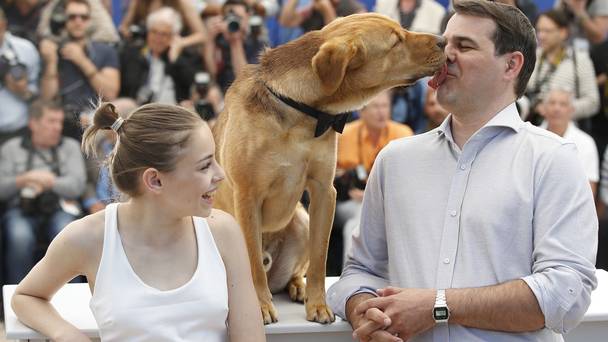White God, Lili and the Tramp in Kornél Mundruczó style
Exclusive interview The film is coming out in Italy with the title, White God Sinfonia per Hagen (White God, Symphony for Hagen), rather than the simpler original title, White Dog, as though […]
 Zsofia Psotta, Hagen and Kornel Mundruczo in Cannes 2014
Zsofia Psotta, Hagen and Kornel Mundruczo in Cannes 2014Exclusive interview The film is coming out in Italy with the title, White God Sinfonia per Hagen (White God, Symphony for Hagen), rather than the simpler original title, White Dog, as though […]
The film is coming out in Italy with the title, White God Sinfonia per Hagen (White God, Symphony for Hagen), rather than the simpler original title, White Dog, as though attempting to lessen the impact of the violence in it.
We have read that the title refers to the work of J.M. Coetzee and that you have also done a piece for theatre from Coetzee’s novel, Disgrace. Can you say something more about all this, not only as regards White God, but also the author’s position on animal rights, especially how the gaze of a dog-god – the play on words doesn’t work in languages other than English – is imagined when scrutinizing us.
The distributor has the right to choose the title that they consider to be appropriate to the microclimate of the given country. There are several different titles of White God, while the film remains the same. It is a basic element of Coetzee’s concept of the world that each living being, i.e., mankind, beasts and plants have their primeval right to survive on Earth to their mutual benefit. Coetzee’s philosophy in general, and his thoughts concerning mankind have had a decisive effect on my attitude towards existence in general, mankind and environment as well as the moral responsibility we should place on others, different races and minorities.
The film also seems to offer a barrier to the rising tide of racism in Europe. In Italy as elsewhere a couple of years ago, media outlets reported a regulation approved in Hungary laying down the extermination of stray dogs. Was this one influence in the film’s development? What was the country’s social situation at that point?
Yes, of course, the fact that the bill forwarded by the right-wing extremist party – and finally rejected by Parliament – aimed to classify dogs and have them taxed according to their species made me so upset that I had to think of expressing my feelings by a film. Ideas like that, any attempt to discriminate against any minority triggers harmful reflexes in a society the history of which has quite a lot of experience with such dead end kinds of processes. Later, As my eyes locked with the death-row prisoner dogs’ eyes at a dog-pound I happened to visit, I realized that even though I hadn’t had the faintest idea of it, I had been part of the system discriminating against another race. It was clear that I should make a film that gives an unequivocal answer to this problem. Being a member of Hungarian society, my social criticism is self-criticism as well.
What or who has in fact disappeared from Budapest’s streets to make them so empty?
The primeval scene I had of this cinema was that of empty streets suddenly run over by a herd of street dogs. For me, an empty street of a down-town quarter means some kind of fear. A kind of postapocalyptic phenomenon. The respectable well-to-do intolerant, the racist, they who soothe their inferiority complexes by discriminating against others have got filled with terror: what comes next might be their fate.
In American cinema, dogs tend to be a reassuring member of the family. Do they have the same status in Hungary? Compared to the symbolic function attributed to horses, we don’t remember dogs with such a role in Hungarian films, except when they are wandering around village streets.
I wouldn’t call this an American speciality. For me, a dog is part and parcel of the family. Actually, that is what they consider themselves to be. They feel content and comfortable if their rank, rights, limits, and responsibilities within the family they belong to are obvious for them. White God tells a tale in which a dog, a true member of a family becomes an outcast and has to go on his moral travels. It is not easy for him to accommodate himself to the circumstances, i.e., his dispossession of rights.
Whether peace takes over or not is a question the audience may decide.
Film directors are often asked how they work with children. In this case, what is it like to work with dogs? We know that the labrador Hagen is in fact played by two siblings, but all the others? What role was played by dog trainers and the special effects department?
My basic concept from the very beginning was not to use any special effect or pure breed animal. It was the extraordinary American dog trainer Teresa Ann Miller who found the two protagonists and transformed the two unwanted lost and found siblings into Hagen. The Hungarian professional Árpád Halász and his team offered our crew the uplifting experience of the miracle: 250 depressed victims of dogcatchers developed into a team of merry dogs willing to cooperate during the filming. They actually thought they were playing with one another and our crew. It is also to be honored as their success that with our adoption program each dog found a loving family.
The film seems like a shout of alarm, in reaction to something that it is already too late to face up to. The economic crisis has turned everyone into defenseless victims, and it may also be a bomb ready to explode. Are there are signs of a coming explosion in Hungary, one of nationalism’s most advanced points in Europe?
It is not easy to answer this question. I am not an oracle. The crisis of the economy led to a kind of moral crisis and that was followed by cost-of-living problems. Uncertainty of existence easily opens the gate for discrimination, nationalism, xenophobia, and the aversion to the West. In Hungary, we have experienced too many examples of disastrous processes. For me, though, Hungary doesn’t seem to be a unique exotic example of extremity any more. It has turned out that there are similar tendencies prevailing in Kobenhavn, Antwerp, Rome, Paris etc. Hungary rather shows the essece of what Europe is drifting towards. Perhaps. Though she should not.
For several years, I attended the Budapest film festival and met directors such as Jancso, Kovacs, Pal Gabor, Metzaros, Gaal… But since the new turn in government policy, the festival has no longer been organized, making it difficult to work out the coordinates of a whole generation of film makers, together with what “cannot be said”. Even if yours is so different from any other film language, your films show traces of an older tradition of abstraction, strength and style, above all in reference to Jancso and his close relationship with history. Even though a young film maker from your quite different contemporary world, what do you see as your reference points in Hungary, in Hungarian or other cinemas?
Miklós Jancsó helped me a lot. Directly, as I asked for and appreciated very much his opinion. Actually White God was the last film he saw and commented on, helping me find the final form of it. He was an extraordinary person. He was able to unravel difficult issues of philosophical nature by means of the cinema keeping their high level of intellectual complexity. He built first time parabola and metaphor into the film language. As for the films I enjoyed very much as a youngster, they were Fassbinder’s movies, then came the expressionist early Soviet films. Later I loved the Hollywood blockbusters, like Blade Runner, the Terminator, etc., just like my peers. The 80’s and 90’s brought the postapocalyptic films the impact of which no one could resist.
I consigli di mema
Gli articoli dall'Archivio per approfondire questo argomento
